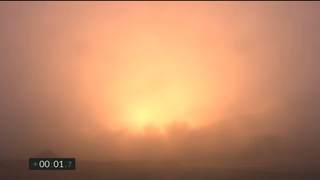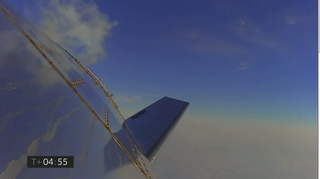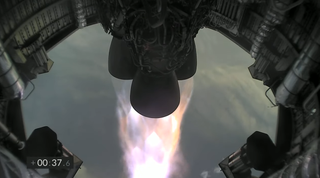SpaceX's Starship SN11 rocket prototype explodes on landing
BOCA CHICA, Texas — SpaceX's latest Starship prototype, SN11, took to the skies over Texas on Tuesday morning (March 30), following a 24-hour delay.
That wasn't the first delay for the test. On Friday (March 25), SpaceX hoped to conduct the test flight after changing out one of the craft's three Raptor engines. Ultimately the test was moved to Monday and then finally happened early Tuesday morning, when the Starship SN11 rocket blasted off from SpaceX's Starbase test site near Boca Chica Village in South Texas at 8 a.m. local time (9 a.m. EDT, 1300 GMT).
The rocket soared to an altitude of 6.2 miles (10 kilometers) before beginning the landing procedure. But at nearly six minutes into the flight, SpaceX's broadcast cameras cut out. "Looks like we've had another exciting test of Starship Number 11," John Insprucker, launch commentator for SpaceX, said during the broadcast. "Starship 11 is not coming back, do not wait for the landing."
Video: Watch SpaceX's Starship SN11 launch on a test flight

SpaceX CEO Elon Musk said something appeared to go wrong with one of SN11's Raptor engines, called engine 2. But that may not be why the rocket crashed.
"Looks like engine 2 had issues on ascent & didn't reach operating chamber pressure during landing burn, but in theory, it wasn't needed," Musk wrote on Twitter. "Something significant happened shortly after landing burn start. Should know what it was once we can examine the bits later today."
Like its predecessors, SN11 did not survive its brief flight, exploding during the test, although the foggy conditions in Boca Chica made it difficult to see.
Sign up for the Live Science daily newsletter now
Get the world’s most fascinating discoveries delivered straight to your inbox.
FAA inspections

The flight, which was the company's second flight test of a Starship rocket this month, was originally planned for Monday afternoon, but was pushed back when an inspector from the Federal Aviation Administration (FAA) could not make it to Boca Chica in time for the launch. (The agency oversees commercial space launches, and needs to have a representative on site for all Starship launches.)
"FAA inspector unable to reach Starbase in time for launch today," Musk wrote in an update on Twitter. "Postponed to no earlier than tomorrow."
The agency now requires an inspector to be on site for all Starship launches, according to the latest launch license that was issued on March 12. The license states that any test flight can take place "only when an FAA Safety Inspector is present at SpaceX's Boca Chica launch and landing site."
The change is a new policy for this test flight and stems from the fact that SpaceX violated its launch license back in December during the launch of its SN8 prototype. In December, the FAA cautioned that the SN8 flight profile exceeded maximum allowed risk for the public in the event of an explosion. That test flight ended in a massive fireball, however, there were no reports of any damage to property outside of SpaceX's test site.
As a result of that explosion, the FAA asked SpaceX to investigate the anomaly, and delayed the flight of its next prototype, SN9. After a thorough review of the company's operational and decision-making process in regards to its Starship program, the FAA gave SpaceX the go-ahead to launch both SN9 and SN10.
Those two prototypes suffered the same fate as SN8, however, SN10 was the first to land intact. (It subsequently exploded a few minutes after landing.)
The FAA's launch oversight is typically done remotely, but with the recent violation by SpaceX, the agency is taking a more hands-on approach and requiring an inspector to be on site. That individual is currently based out of Florida and has to travel between the two facilities.
SpaceX is building its Starship program at a rapid pace, and as such can change expected launch dates and times on short notice. Its launch facilities are also in the middle of Boca Chica Village and requires SpaceX to issue road closures and evacuate residents, all of which take time to organize.
According to sources familiar with the incident, the inspector was in Texas ahead of the planned launch, but went home to Florida as the agency thought the test would be pushed back. Typically the FAA waits until a static fire test has been completed before sending an inspector to Texas, but is now looking into having an inspector in Texas to handle Starship. The agency also is requiring SpaceX to give adequate notice so an inspector can be on site.

Fourth time's a charm?
The weather in Boca Chica is very dynamic, and changes almost hourly, as evident by the fact that the area was covered in a dense fog early Tuesday morning. That fog did not dissipate before the test, shrouding Starship as it soared into the sky.
SpaceX has various other Starship prototypes in different phases on construction at its site here in Boca Chica, and with another failed landing attempt, it looks like the next prototype and SpaceX have some work to do before orbital flights can happen later this year.

Eventually the vehicle will be used to transport humans to the moon and Mars and will be stacked on top of a Super Heavy booster. The first prototype of that first stage is currently tucked away in a high bay. The massive craft will be used to test the design's structure in the near future.
SpaceX has big plans for its Starship/Super Heavy combo as the company already has one flight booked for Japanese billionaire Yusaku Maezawa and eight other people to fly around the moon in a Starship. That mission, called "dearMoon," is targeted to launch in 2023. SpaceX's Starship is also one of three designs that could deliver NASA astronauts to the moon under the agency's Artemis lunar program.
Editor's note: This story has been updated to include new details on the Starship SN11 crash from Elon Musk.
Follow Amy Thompson on Twitter @astrogingersnap. Follow us on Twitter @Spacedotcom or Facebook.

